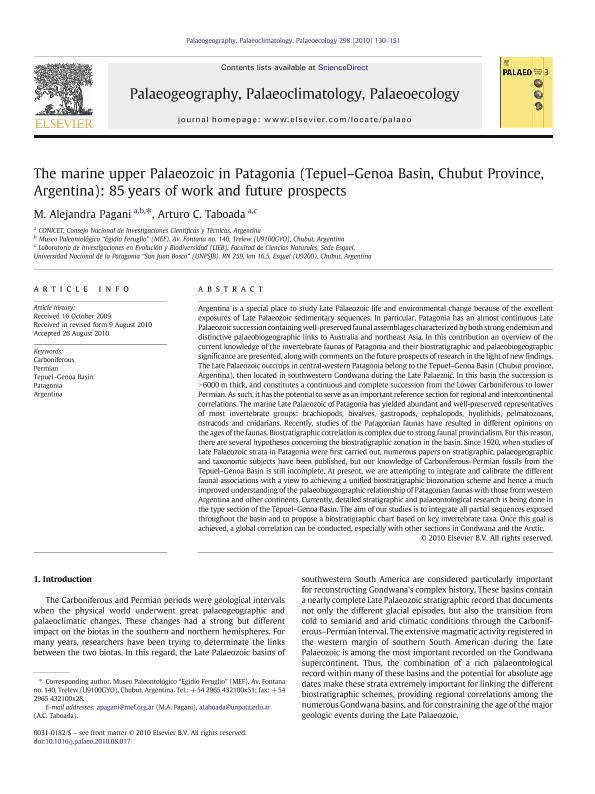Mostrar el registro sencillo del ítem
dc.contributor.author
Pagani, María Alejandra

dc.contributor.author
Taboada, Arturo Cesar

dc.date.available
2019-09-26T22:04:26Z
dc.date.issued
2010-12
dc.identifier.citation
Pagani, María Alejandra; Taboada, Arturo Cesar; The marine upper Palaeozoic in Patagonia (Tepuel-Genoa Basin, Chubut Province, Argentina): 85 Years of work and future prospects; Elsevier Science; Palaeogeography, Palaeoclimatology, Palaeoecology; 298; 1-2; 12-2010; 130-151
dc.identifier.issn
0031-0182
dc.identifier.uri
http://hdl.handle.net/11336/84633
dc.description.abstract
Argentina is a special place to study Late Palaeozoic life and environmental change because of the excellent exposures of Late Palaeozoic sedimentary sequences. In particular, Patagonia has an almost continuous Late Palaeozoic succession containing well-preserved faunal assemblages characterized by both strong endemism and distinctive palaeobiogeographic links to Australia and northeast Asia. In this contribution an overview of the current knowledge of the invertebrate faunas of Patagonia and their biostratigraphic and palaeobiogeographic significance are presented, along with comments on the future prospects of research in the light of new findings. The Late Palaeozoic outcrops in central-western Patagonia belong to the Tepuel-Genoa Basin (Chubut province, Argentina), then located in southwestern Gondwana during the Late Palaezoic. In this basin the succession is > 6000 m thick, and constitutes a continuous and complete succession from the Lower Carboniferous to lower Permian. As such, it has the potential to serve as an important reference section for regional and intercontinental correlations. The marine Late Palaeozoic of Patagonia has yielded abundant and well-preserved representatives of most invertebrate groups: brachiopods, bivalves, gastropods, cephalopods, hyolithids, pelmatozoans, ostracods and cnidarians. Recently, studies of the Patagonian faunas have resulted in different opinions on the ages of the faunas. Biostratigraphic correlation is complex due to strong faunal provincialism. For this reason, there are several hypotheses concerning the biostratigraphic zonation in the basin. Since 1920, when studies of Late Palaeozoic strata in Patagonia were first carried out, numerous papers on stratigraphic, palaeogeographic and taxonomic subjects have been published, but our knowledge of Carboniferous-Permian fossils from the Tepuel-Genoa Basin is still incomplete. At present, we are attempting to integrate and calibrate the different faunal associations with a view to achieving a unified biostratigraphic biozonation scheme and hence a much improved understanding of the palaeobiogeographic relationship of Patagonian faunas with those from western Argentina and other continents. Currently, detailed stratigraphic and palaeontological research is being done in the type section of the Tepuel-Genoa Basin. The aim of our studies is to integrate all partial sequences exposed throughout the basin and to propose a biostratigraphic chart based on key invertebrate taxa. Once this goal is achieved, a global correlation can be conducted, especially with other sections in Gondwana and the Arctic.
dc.format
application/pdf
dc.language.iso
eng
dc.publisher
Elsevier Science

dc.rights
info:eu-repo/semantics/openAccess
dc.rights.uri
https://creativecommons.org/licenses/by-nc-sa/2.5/ar/
dc.subject
ARGENTINA
dc.subject
CARBONIFEROUS
dc.subject
PATAGONIA
dc.subject
PERMIAN
dc.subject
TEPUEL-GENOA BASIN
dc.subject.classification
Paleontología

dc.subject.classification
Ciencias de la Tierra y relacionadas con el Medio Ambiente

dc.subject.classification
CIENCIAS NATURALES Y EXACTAS

dc.title
The marine upper Palaeozoic in Patagonia (Tepuel-Genoa Basin, Chubut Province, Argentina): 85 Years of work and future prospects
dc.type
info:eu-repo/semantics/article
dc.type
info:ar-repo/semantics/artículo
dc.type
info:eu-repo/semantics/publishedVersion
dc.date.updated
2019-09-20T15:11:01Z
dc.journal.volume
298
dc.journal.number
1-2
dc.journal.pagination
130-151
dc.journal.pais
Países Bajos

dc.journal.ciudad
Amsterdam
dc.description.fil
Fil: Pagani, María Alejandra. Consejo Nacional de Investigaciones Científicas y Técnicas; Argentina. Museo Paleontológico Egidio Feruglio; Argentina
dc.description.fil
Fil: Taboada, Arturo Cesar. Consejo Nacional de Investigaciones Científicas y Técnicas. Centro Científico Tecnológico Conicet - Patagonia Norte. Centro de Investigación Esquel de Montaña y Estepa Patagóica. Universidad Nacional de la Patagonia "San Juan Bosco". Facultad de Ciencias Naturales - Sede Esquel. Centro de Investigación Esquel de Montaña y Estepa Patagónica; Argentina
dc.journal.title
Palaeogeography, Palaeoclimatology, Palaeoecology

dc.relation.alternativeid
info:eu-repo/semantics/altIdentifier/url/https://www.sciencedirect.com/science/article/pii/S0031018210005110
dc.relation.alternativeid
info:eu-repo/semantics/altIdentifier/doi/https://doi.org/10.1016/j.palaeo.2010.08.017
Archivos asociados
